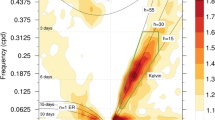Abstract
Saline circulation forced by fresh water alone is studied for a broad region of parameter space by varying the amplitude and profile of evaporation minus precipitation, the vertical and horizontal mixing of salt, vertical and horizontal dissipation of momentum, and the horizontal resolution. The model is a modified Bryan-Cox model with a freshwater flux as the natural boundary condition for the salinity balance. For a model forced by a linear freshwater flux profile, as the amplitude of freshwater flux is increased from 0.01 m year −1 to 1 m year−1 with other parameters fixed, the system evolves from a steady state of no oscillation to a state of periodic oscillation whose frequency increases almost linearly with the amplitude of freshwater flux. When the freshwater flux is fixed and the vertical mixing coefficient is increased from 0.5 to 2.5 cm2s−1, the system evolves from a steady state to a state of single-period oscillation, chaotic, a single period, and finally to a chaotic state when the vertical mixing coefficient is larger than 2 cm2 s−1. One set of numerical experiments forced by a cosine shape of freshwater flux clearly reveals the transition from a state of single period oscillation to period doubling, period quadrupling, and a state of chaotic oscillation. Simple scaling analysis and numerical experiments indicate that the strength of the meridional overturning increases with the square-root of the vertical mixing and the 1/4 power of the freshwater flux. The mean sea surface salinity (deviation from 35 psu) increases with the 3/4 power of the freshwater flux and decreases with the 1/2 power of the vertical salt mixing.
Similar content being viewed by others
References
Broecker WS, Bond G, Klas M, Bonani G, Wolfli W (1990) A salt oscillator in the glacial Atlantic? 1. The concept. Paleoceanography 5:469–477
Bryan F (1986) High-latitude salinity effects and interhemispheric thermohaline circulations. Nature 323:301–304
Bryan F (1987) Parameter sensitivity of primitive equation ocean general circulation models. J Phys Oceanogr 17:970–985
Bryan K (1969) A numerical method for the study of the circulation of the world ocean. J Comput Phys 4:347–376
Bryan K, Manabe S, Pacanowski RC (1975) A global oceanatmosphere climate model. Part II. The oceanic circulation. J Comput Plays 15:30–46
Cox MD (1984) A primitive equation, 3-dimensional model of the ocean. GFDL Ocean Group Tech Rep No 1, GFDL/Princeton University
Goldsbrough GR (1933) Ocean currents produced by evaporation and precipitation. Proc R. Soc London A141:512–517
Huang RX (1993a) A two-level model for the wind and buoyancy forced circulation. J Phys Oceanogr 23:104–115
Huang RX (1993b) Real freshwater flux as a natural boundary condition for the salinity balance and thermohaline circulation forced by evaporation and precipitation. J Phys Oceanogr (in press)
Marotzke J, Willebrand J (1991) Multiple equilibria of the global thermohaline circulation. J Phys Oceanogr 21:1372–1385
Pedlosky J, Frenzen C (1980) Chaotic and periodic behavior of finite-amplitude baroclinic waves. J Atmos Sci 37:1177–1196
Stommel HM (1957) A survey of ocean current theory. Deep-Sea Res 4:149–184
Walin G (1985) The thermohaline circulation and the control of ice ages. Palaogeogr Palaeoclimatol Palaeoecol 50:323–332
Wang D (1993) Modeling deep equatorial circulation. PhD thesis, University of Hawaii
Weaver AJ, Sarachik ES (1990) On the importance of vertical resolution in certain ocean general circulation models. J Phys Oceanogr 20:600–609
Weaver AJ, Sarachik ES (1991) The role of mixed boundary conditions in numerical models of the ocean's climate. J Phys Oceanogr 21:1470–1493
Weaver AJ, Sarachik ES, Marotzke J (1991) Freshwater flux forcing of decadal and interdecadal oceanic variability. Nature 355:836–838
Weaver AJ, Marotzke J, Cummins PF, Sarachik ES (1993) Stability and variability of the thermohaline circulation. J Phys Oceanogr 23:39–60
Welander P (1986) Thermohaline effects in the ocean circulation and related simple models. In: Willebrand J, Anderson DLT (eds) Large-scale transport processes in oceans and atmosphere. D Reidel, Dordrecht, pp 163–200
Winton M, Sarachik ES (1993) Thermohaline oscillations induced by strong steady salinity forcing of ocean general circulation models. J Phys Oceanogr (in press)
Wright DG, Stocker TF (1992) Sensitivity of a zonally averaged global ocean circulation model. J Geophys Res 97:12707–12730
Author information
Authors and Affiliations
Additional information
Contribution No. 8191 from the Woods Hole Oceanographic Institution
Rights and permissions
About this article
Cite this article
Xin Huang, R., Ling Chou, R. Parameter sensitivity study of the saline circulation. Climate Dynamics 9, 391–409 (1994). https://doi.org/10.1007/BF00207934
Received:
Accepted:
Issue Date:
DOI: https://doi.org/10.1007/BF00207934




